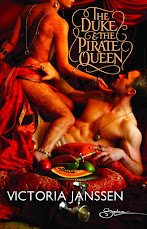
There are plenty of werewolf types I haven't yet seen in paranormal romance, and I'm wondering if, as the subgenre ages, we'll see more different types, as writers try to stand out from the crowd and as readers grow tired of the "same old thing."
Here are a few to get you started:
The Lobisón is of Argentinian and Brazilian origin. The idea is that the seventh son in a row (daughters don't count in the seven, and a seventh daughter in a row will be a witch) will turn into a werewolf. The Lobisón spends the rest of his life wandering in the wild, eating carrion, and attacking any humans he sees; if the human survives his bite, the saliva turns them into a Lobisón as well. He'd make a great character for a Gothic, wouldn't he? Or, of course, a "Beauty and the Beast" story.

The Finnish werewolf usually is cursed to have the second form, either from being bespelled or accidentally breaking a taboo. They aren't usually happy about this, and hang around houses, hoping to be recognized for their true self (a perfect romance theme!). They eat animals for the most part, rather than attacking people. Cures include being called by their true name or being fed bread, or both. And perhaps True Love could factor in?
Portugese werewolves are called lobis-homems, easily spotted because of their short yellow tails. Like the Finnish werewolves, the transformational ability was bestowed by a spell. The curse compels the victim to roll in crossroads dirt, which incites them to change into wolf-form and run howling into the night. They don't attack humans, except when the lobis-homem was created by evil arts; the evil ones are set apart by the presence of a demonic mark somewhere on their body, or something strange about their eyes.
This is a classic book on werewolves, and often cited: The Book of Werewolves
If anyone has any good resources on different types of werewolves, please pass them on!
Related posts:
Paranormal Appropriation.
Romancing the Beast.
Why Werewolves?
Werewolves in Moonlight Mistress.




Good post, Victoria! Offers some ideas for the creative mind to expand on. I particularly like the Finnish werewolf. Hmmm. The makings of a romantic mystery are already churning in my psyche...
ReplyDeleteJust reading these myths sent mental plots racing through my head.
ReplyDeleteI'm partial to Japanese kitsunes but those aren't wolves...
ReplyDeleteVictoria, wow, I hadn't heard of those werewolves. In one of my mss I used the field research of Linda Godfrey ~ check out her BEAST OF BRAY ROAD and other books.
ReplyDeleteAlso, I've heard several Ye Olde England tales about werewolves on Coast to Coast am, night time paranormal radio, that are considered to be real by some. Lionel Fanthorpe is a story teller and also does research into the paranormal, including werewolves.
I also use the Atlantis connection in another wolf shifter WIP, where they created human-animal hybrids by various means, mostly through the manipulation of genetics.
My problems is getting back to those two stories, revising, etc ~ I'm pretty darn certain they would sell, but I have of other author obligations, right now.
BEAST OF BRAY ROAD is an awesome title!
ReplyDelete